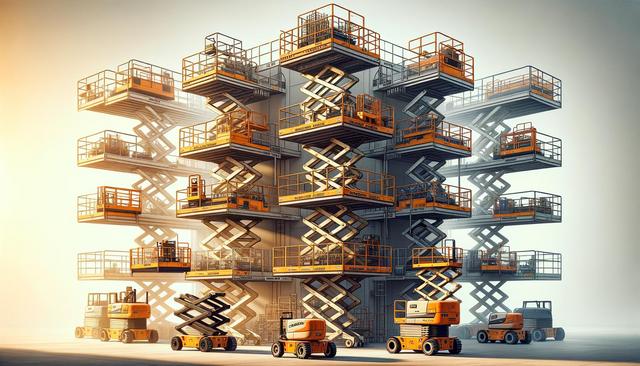Understanding the Basics of Scissor Lifts
Scissor lifts are a type of aerial work platform designed to elevate workers and equipment to various heights. Unlike boom lifts, which can extend horizontally, scissor lifts move vertically, making them particularly useful in confined spaces or where vertical reach is the primary requirement. These lifts are commonly used in construction, maintenance, warehousing, and manufacturing environments. Their signature crisscrossing metal supports, which elongate as the platform rises, provide stability and strength during operation.
There are several types of scissor lifts available, including electric, diesel, and hydraulic models. Each type is suited to different environments. For example, electric scissor lifts are ideal for indoor use due to their quiet operation and zero emissions, while diesel-powered models are better suited for outdoor applications where rugged terrain may be a factor. Hydraulic lifts offer simplicity and ease of use, making them a solid choice for general-purpose tasks.
Choosing the Right Scissor Lift for Your Needs
Selecting the appropriate scissor lift depends on a few key factors, such as the height requirement, load capacity, and the type of surface where the equipment will be used. To make an informed decision, consider the following:
- Height Access: Determine the maximum elevation you need to reach. Some lifts can extend up to 50 feet or more.
- Weight Capacity: Assess the weight of personnel, tools, and materials that will be on the platform simultaneously.
- Work Environment: Identify whether the lift will be used indoors or outdoors, and whether the surface is smooth or uneven.
Additionally, think about how frequently the lift will be used and whether it will be operated by trained personnel. Investing in a model with advanced safety features and ease of maneuverability can enhance productivity and reduce operational risks.
Applications and Industry Use Cases
Scissor lifts serve a wide range of industries, thanks to their ability to safely elevate workers in a vertical motion. They are commonly used in:
- Construction: For installing ceilings, ductwork, electrical systems, and drywall in multi-story buildings.
- Warehousing: To access high shelves, perform inventory checks, and carry out routine maintenance tasks.
- Retail and Facilities Management: For changing signage, lighting maintenance, and seasonal decorations in large commercial spaces.
- Manufacturing: To provide safe access to overhead equipment and structures during production or maintenance.
The versatility of scissor lifts makes them an essential tool across these sectors, offering a dependable alternative to ladders and scaffolding. Their compact footprint and ease of control help streamline operations while maintaining high safety standards.
Safety Considerations and Operator Training
Operating a scissor lift safely requires proper training and adherence to safety protocols. Most workplace accidents involving aerial lifts stem from misuse or lack of training. Therefore, it’s critical to ensure that all operators are certified and familiar with the specific model they are using.
Here are some standard safety practices to follow:
- Inspect the lift before use – Check the platform, guardrails, and controls for any signs of damage or malfunction.
- Stabilize the base – Always ensure the lift is on a level surface and use stabilizers if needed.
- Wear fall protection – Even though scissor lifts have guardrails, wearing a harness can provide an extra layer of safety.
- Follow load limits – Never exceed the recommended weight capacity, including personnel and equipment.
- Be aware of surroundings – Identify any overhead obstacles or potential hazards before raising the platform.
Organizations should establish clear protocols for lift operation and maintain a schedule for regular inspections and maintenance. Doing so not only ensures compliance with safety regulations but also extends the life of the equipment.
Buying vs. Renting a Scissor Lift
Whether to buy or rent a scissor lift depends on the frequency and duration of its intended use. Both options have their advantages, and understanding your specific needs will help determine the most cost-effective solution.
Renting might be the right choice if:
- You need the equipment for a short-term project.
- You want to test different models before committing to a purchase.
- You prefer not to handle maintenance and storage.
Purchasing may be more beneficial if:
- You use the lift regularly as part of daily operations.
- You want full control over the equipment’s availability and condition.
- Your business has trained personnel to handle maintenance and repairs.
Cost considerations should include not only the initial investment but also long-term factors such as servicing, parts replacement, and operator training. Many businesses also explore financing or leasing options, which can provide flexibility while managing capital expenditures.
Conclusion: Making the Right Choice
Scissor lifts are a practical and efficient solution for safe access to elevated workspaces across various industries. By understanding the different types available and evaluating your specific needs—such as height, weight capacity, and environment—you can make informed decisions that support both productivity and safety. Whether renting or purchasing, ensuring proper training and routine maintenance will help you get the most value from your equipment. With the right approach, scissor lifts can become a reliable asset in your operational toolkit.




Leave a Reply